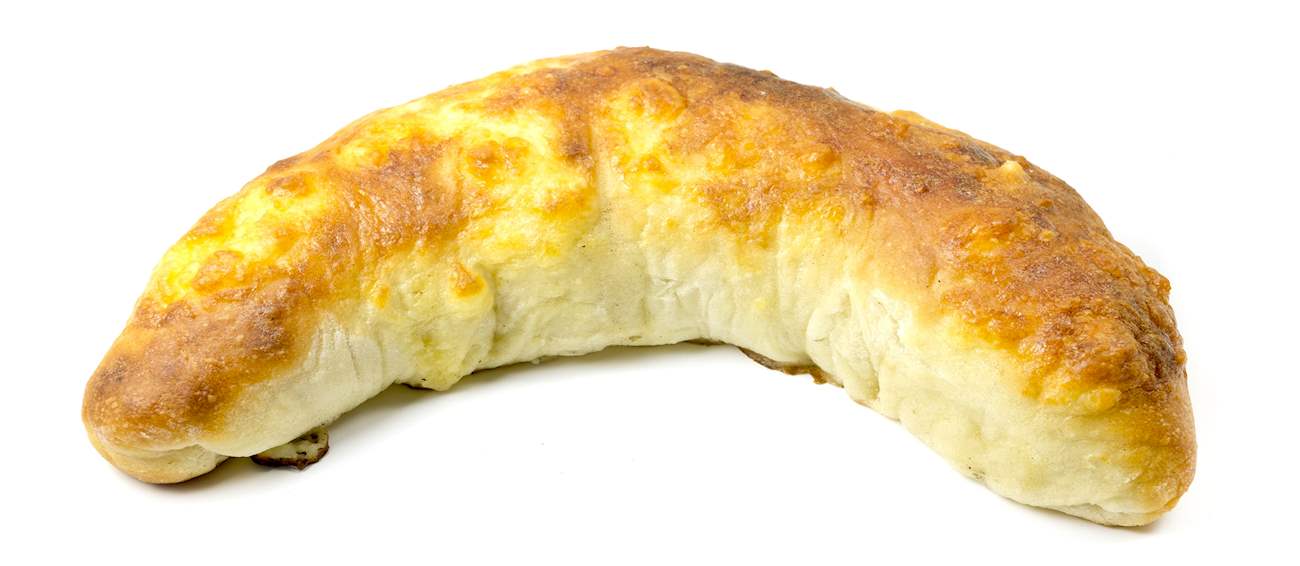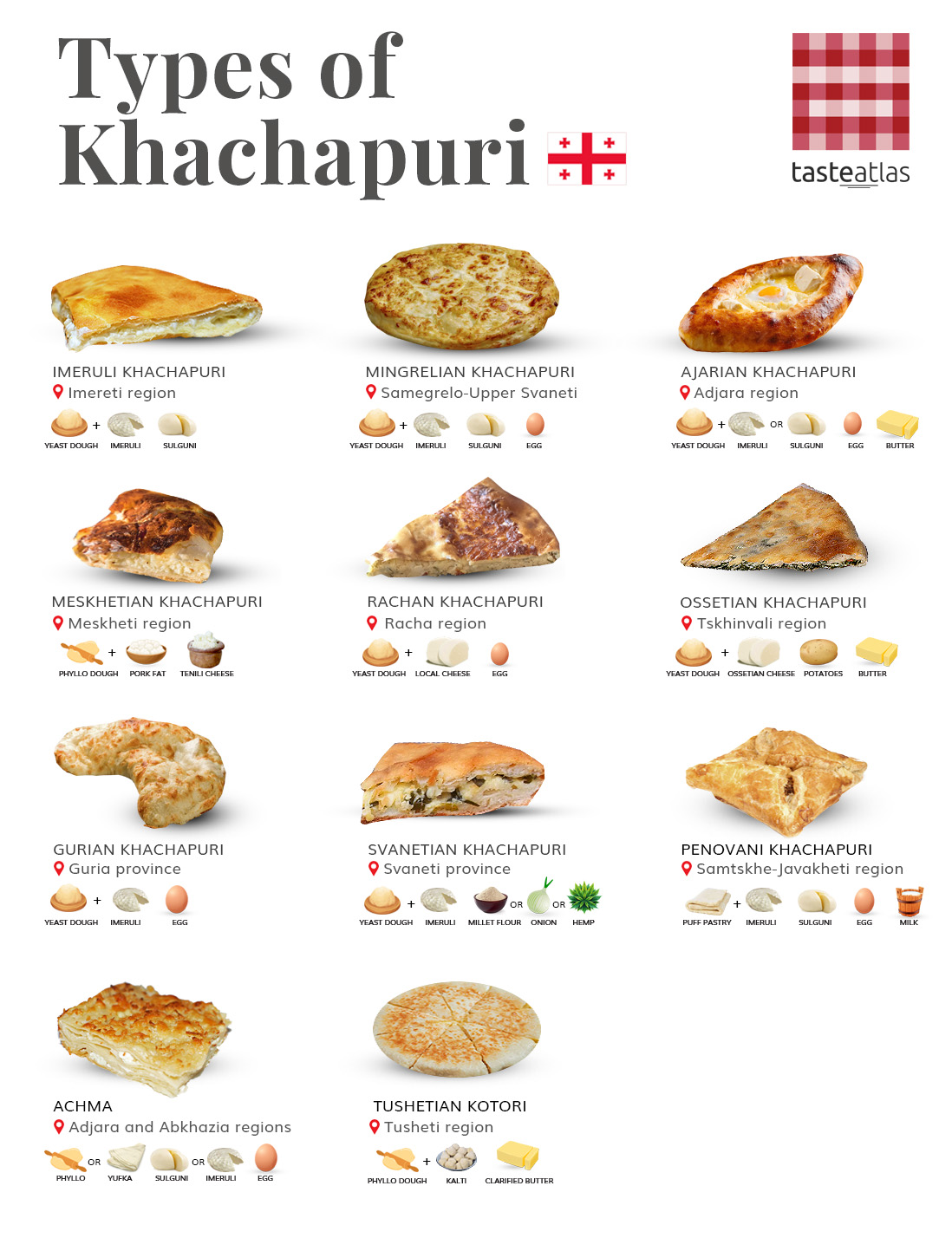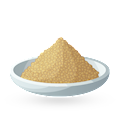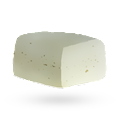MAIN INGREDIENTS
This simple cheese bread known as khachapuri is the most famous dish in Georgia. It is traditionally topped with melted cheese, eggs and butter. There are different types of khachapuri, and even though some new cheese varieties such as mozzarella and feta have been incorporated in the dish, the most common additions still include traditional Georgian Sulguni or Imeretian cheese.
It is shaped into different forms, and depending on the baking procedure and its form, it can be consumed individually or shared. Two of the most common varieties include the Imeretian khachapuri, shaped into a circular form, and Adjaran khachapuri, the open-faced version topped with butter and a raw egg on top.
VARIATIONS OF Khachapuri
MOST ICONIC Khachapuri
View moreMAIN INGREDIENTS
This khachapuri variety hails from Guria, a province in the west of Georgia. Unlike other khachapuri pies, this one is crescent-shaped and it's prepared for Orthodox Christmas. The dough is filled with a combination of grated Imeruli cheese and hard-boiled eggs before it's baked until golden-brown.
The shape of this pie was associated with celestial bodies, and for ancient Gurians it was a symbol of strength, so nowadays there is a superstitious belief that each family member should get at least one Gurian khachapuri during the festive Christmas season.
MAIN INGREDIENTS
One of the most popular khachapuri varieties, adjarian is an open-faced pie that is filled with a combination of cheese and eggs. The base is made from yeasted dough that is rolled into an oblong shape and traditionally comes filled with Sulguni or Imeretian cheese, or the combination of both.
The dish is finished off with an egg that is placed on top, and the pie is then additionally baked until the egg is partially set. This boat-shaped pie hails from the coastal Adjaria region, and it is usually served with a slice of butter on top.
MOST ICONIC Ajaruli khachapuri
View moreMAIN INGREDIENTS
Mingrelian khachapuri is a Georgian khachapuri variety originating from Samegrelo. Although it's quite similar to its Imeretian cousin, this khachapuri is round and it's topped with even more cheese (usually chkinti-kveli Imeretian cheese).
The dough is prepared with flour, water, yeast, sugar, and salt. Once it has risen, the dough is topped with a combination of eggs and cheese, then baked until the cheese becomes bubbly and golden brown. Before serving, this khachapuri variety can be rubbed with butter, if desired.
This khachapuri variety hails from Georgia's Svaneti region, hence the name. The dough is the same as the one used for other types of khachapuri, while the filling is made with a combination of high-fat cheese, eggs, and green onions. The dough is wrapped around the filling, and it is then pressed into a circular shape before being baked until golden brown.
It is then brushed with butter and served hot, usually in slices or wedges.
MAIN INGREDIENTS
Imeruli khachapuri is a traditional bread filled with melted cheese. Unlike traditional khachapuris, the imeruli variety is circular in shape. The dough consists of flour, salt, sugar, yeast, water, and sometimes yogurt, while the cheese filling is usually enriched with the addition of eggs.
It is recommended to glaze imeruli khachapuri with butter as soon as it is out of the oven and serve it while it is still hot.
Penovani khachapuri is a Georgian khachapuri variety originating from Samtskhe-Javakheti. In order to prepare it, a combination of Imeruli and Sulguni cheese is grated and combined with egg yolks. The mixture is placed on a piece of puff pastry that's folded into triangles or squares.
Before baking, each khachapuri is brushed with a mix of egg yolks and milk. These tasty small pies are ready for consumption after they puff up in the oven and become golden brown. This khachapuri variety is the easiest, speediest, and simplest to make of all the khachapuri versions.
This khachapuri variety originates from Ossetia, Georgia. Similar in shape to the Imeruli khachapuri, this one is made with boiled potatoes and cheese that are folded between two layers of dough. People love this khachapuri variety because the cheese is creamier than the one found in Imeruli khachapuri, and it is also less salty.
MAIN INGREDIENTS
Mkhlovani is a traditional stuffed pie originating from the mountainous regions, including the nearby Ossetia. The dough for the pie is usually made with a combination of flour, sugar, salt, yeast, and oil, while the filling is made with a mixture of greens (such as spinach, dill, or beetroot leaves), butter, salt, walnuts, eggs, and cheese such as Sulguni.
The herbs are chopped and mixed with grated cheese, eggs, and walnuts. The dough is flattened, stuffed with the filling, and the dough is then closed around it in order to create disk-like shapes. The mkhlovani is baked in a pan over medium heat. Once golden brown and crisp, this stuffed pie is often dotted with butter and served hot.
MAIN INGREDIENTS
Tarkhunis ghvezeli is a traditional pie originating from the eastern parts of the country. The dough is usually made with a combination of flour, yeast, eggs, butter, milk, and salt. The balls of dough are rolled into a circle that's placed into a baking pan, and it's then filled with a mixture of sautéed onions, scallions, and tarragon leaves.
Chopped hard-boiled eggs and black pepper are sprinkled on top, and everything is dotted with butter. Another layer of dough goes on top, the pie is sealed, brushed with egg yolks, pricked with a fork, and then baked until the pie becomes golden brown.
TasteAtlas food rankings are based on the ratings of the TasteAtlas audience, with a series of mechanisms that recognize real users and that ignore bot, nationalist or local patriotic ratings, and give additional value to the ratings of users that the system recognizes as knowledgeable. For the “Top 10 Georgian Pies” list until April 15, 2025, 3,126 ratings were recorded, of which 944 were recognized by the system as legitimate. TasteAtlas Rankings should not be seen as the final global conclusion about food. Their purpose is to promote excellent local foods, instill pride in traditional dishes, and arouse curiosity about dishes you haven’t tried.












